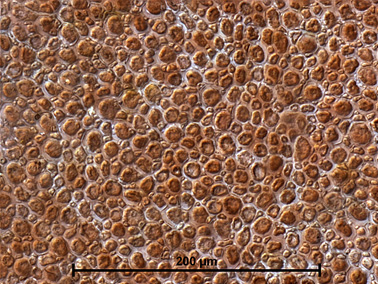
Bands or zones of growth 10-20 cm wide on concrete walls of the West Beach marina, exposed at low tide and between waves. Upper green band of a wiry green alga (Chaetomorpha linum); lower band of red mat algae (L. monochlamydea and Gigartina brachiata). Photo: B. Baldock.
A diminutive turf-like red alga, Lomentaria monochlamydea (J.Agardh) Kylin, has been found growing as a band of turf on the concrete wall of the West Beach boat marina, Adelaide. This species has been known previously from asexual spore plants, but female and male plants have now been found for the first time in South Australia by State Herbarium Hon. Research Associate Bob Baldock and phycology staff member Carolyn Ricci. Why the excitement? — Well, descriptions of red algal species are never complete until the three separate plants – female, male and spore plants – have been found.
This alga has flattened, yet surprisingly, hollow branches and a growth pattern described by Allan Millar when he found it at Coffs Harbour in NSW as saltatory or “skipping” — an arched horizontal runner puts up vertical branches, pinched at the base, touches the rock or jetty pile surface, then continues on in “leaps and bounds” forming bright red, tangled mats.

Intertwined plants of L. monochlamydea (left) and the cohabiting red mat plant, Gigartina brachiate (right). The coin used as a scale is 23 mm across (or about 1” in diameter). Photos: B. Baldock.
For a while plants found at the West Beach marina were so intermingled with another intertidal red alga, Gigartina brachiata (tangled Gigartina), that we failed to spot that we were looking at two entities. Can you see the differences in the two images above? One is a littler darker in colour with more pointed branch tips?
Once back in the lab and sectioned under the microscope, features of the anatomy made identification easy. (This protracted procedure is often necessary and explains why getting an identification of an alga takes time — and experience.)

Silhouette view of a cluster of flask-shaped female structures at the base of a branch (left) and section view (right) with central mass of spores that grow into a separate asexual plant when released, continuing the life cycle of L. monochlamydea. Photo: B. Baldock.
Female structures after fertilisation produce bodies (actually separate stages vaguely like wombs and embryos in mammals) that look like miniature flasks. No “babies” are produced, however, just spores that germinate into sexless (asexual) plants when released through the opening in the duck-bill-like flask beak.
Male structures are pretty obscure — merely extremely small cells that ring each cortical or “skin” cell in patches on branch surfaces (see image below).
We have yet to locate a critical stage in female reproduction where a microscopic fertile cell (carpogonium) with a long terminal hair (trichogyne) snares a sperm cell floating past and fertilisation is accomplished, inducing the flask (cystocarpic) stage to develop.

Surface of a male plant. Extremely small spermatia form as rings around the larger surface cells. Photo: B. Baldock.
Lomentaria monochlamydea has not often been collected, so it is difficult to make a pronouncement about its distribution. It was first collected in Pt Phillip Bay, Victoria, is found along the NSW coast and there are a few female specimens in the Western Australia Herbarium (although these are attached to another red alga and may be a different species). Previously, in South Australia, it has been collected at the Pt Stanvac jetty and at Robe in shallow water.
Perhaps it has been overlooked or mistaken for Gigartina brachiata, as we initially did at the State Herbarium — which suggests there is a lot more searching and collecting still to come before closing the books on Lomentaria monochlamydea.
